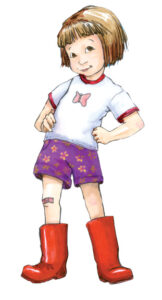
The Education of Ramona Quimby: First Grade
 In the previous blog in this series, we learned from Ramona Quimby’s kindergarten teacher, Miss Binney, that there is value to connecting with students. To writing them notes. To communicating that they matter in the classroom. To giving a shit.
In the previous blog in this series, we learned from Ramona Quimby’s kindergarten teacher, Miss Binney, that there is value to connecting with students. To writing them notes. To communicating that they matter in the classroom. To giving a shit.
But sometimes we just have no shits left to give. Miss Binney was an unseasoned pedagogue. She possessed the eagerness of youth. When she printed Ramona’s name, she, like Ramona, always added kitty-cat ears and whiskers to the Q. “That was the kind of teacher Miss Binney was.” One who still had many shits to give.
Mrs. Griggs, Ramona’s first grade teacher in Ramona the Brave, does not. And I don’t think we should begrudge her for it.
The narrator describes her physical appearance as such: “Mrs. Griggs, older than Miss Binney, looked pleasant enough, but of course she was not Miss Binney. Her hair, which was no special color, was parted in the middle and held at the back of her neck with a plastic clasp.”
Mrs. Griggs’s unremarkable appearance matches her no-nonsense pedagogical vibe: she is in the classroom to guide the students in the hard work of the first grade, which she consistently reminds them is not, like kindergarten, a place to play.
Part of the hard work of the first grade is becoming literate. Ramona’s burgeoning literacy is one of two pedagogical themes that punctuate Ramona the Brave. When the first grade begins, Ramona can read three grown-up words that she taught herself from road signs: gas, motel, and burger. She is consistently disappointed, as they rarely appear in literature.
The other recurring pedagogical theme in the novel is the big emotions that Ramona brings to the classroom. These begin on day one of first grade. Ramona has been eagerly awaiting the start of school. For once she has something really interesting to share with her peers during Show and Tell: at the end of summer, some workmen came and “chopped a hole” in her house.
This revelation does not receive the reaction Ramona anticipated. Rather than being amazed, the class laughs. The laughter stings, but insult is added to injury when Ramona’s best friend, Howie Kemp, who himself had jumped through the hole in the house, refuses to publicly confirm the hole chopping. As Ramona’s rage boils, Mrs. Griggs addresses the situation: “‘Ramona,’ said Mrs. Griggs, in a voice that was neither cross nor angry, ‘You may take your seat. We do not shout in the first grade.’”
Ramona seethes at the injustice of the situation and refuses to participate actively in the class the remainder of the day, “even though she ached to give answers.”
Things get worse over the next month. Ramona remains despondent. Mrs. Griggs has said every day since the first grade began, “We are not in kindergarten any longer. We are in the first grade, and people in the first grade must learn to be good workers.” Mrs. Griggs does not seem to recognize what a good worker Ramona is. She has learned the words bunny, apple, and airplane, along with all the others in her new graduated reader.
And then come the paper bag owls. Ramona constructs a perfect bird: bespectacled with eyes peering off to the side and covered with little Vs to make it look feathered. But, to Ramona’s horror, Snoozin’ Susan Kushner’s owl looks just the same as Ramona’s. Mrs. Griggs holds up Susan’s owl for the entire class to admire. Knowing that her teacher will tell her “Nobody likes a tattletale” and the class will call her Ramona Copycat instead of Ramona Kitty Cat if she narks, Ramona says nothing about Susan’s academic dishonesty. Instead, she crushes both her and Susan’s owl and slams them into the trash can.
The behavioral snafu is addressed by Mrs. Griggs at parent-teacher conferences, which Ramona is absent from. She remains at home, feeling proud that she could read bits of the evening newspaper, learning that the z-z-z-z-z-s were going to play the z-z-z-z-z-s in z-z-z-z-ball.
The Quimby family debriefs the conference and reports that Mrs. Griggs expects Ramona to apologize to Susan. Ramona’s older sister, Beatrice, who was also in Mrs. Griggs’s class in the first grade, recalls (interrupted by Ramona feeling frustrated and screaming the most-vulgar word she can possibly think of: “guts!”) that Mrs. Griggs was always big on apologies. She also reports that Mrs. Griggs operated with a monotonous, consistent curriculum: “We just seemed to go along with our work, and that was it.” Beatrice got along well with Mrs. Griggs because she was the kind of student that she liked: neat and dependable, very un-Ramona.
The report indicates that Ramona is progressing well with her reading and math, but that she needs to work on exhibiting self-control in the classroom. Ramona thinks the feedback unmerited and asks why she cannot change to the other first grade class. In response, Ramona’s father, Robert Quimby, drops these golden nuggets of pedagogical wisdom:
Because Mrs. Griggs is teaching you to read and do arithmetic, and because the things she said about you are fair. You do need to learn self-control and keep your hands to yourself. There are all kinds of teachers in the world just as there are all kinds of other people, and you must learn to get along with them.
As teachers, we bring not only our methods but our persons to the classroom. Who we are matters there. Not all humans get along swimmingly with all other humans. That’s okay. Not all professors get along swimmingly with all students. That’s okay.
It is a kindness to ourselves to find out what works for us in our classrooms and repeat those things. If we are constantly reinventing the wheel, eventually we will run out of inventions.
It is a kindness to students to find what works for the widest variety of students and repeat those things. It is also a kindness to students to have some flexibility with respect to some course policies, practices, and assignments. A bend-but-don’t-break model of teaching.
Just as students, like Ramona, must learn to get along with all kinds of teachers, so also teachers must learn to get along with all kinds of students. Because, to echo the wise Mr. Quimby, there are all kinds of students in this world just as there are all kinds of other people.
And Mrs. Griggs learns to get along with Ramona, big personality and all. At the end of Ramona the Brave, Ramona loses one of her shoes on the way to school (she had to throw it at a ferocious, sharp-toothed dog). Rather than make a paper turkey, Ramona requests that her teacher allow her to make a paper slipper. Mrs. Griggs begins to balk, “We always—”, before changing her mind and allowing an educational audible. This is much to Ramona’s delight, who now feels she no longer needs to dread turkeys or her teacher.
Leave a Reply